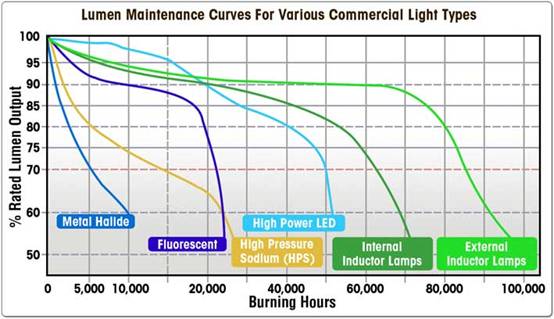LED Lifespan: Lumen Maintenance & Your Light Fixtures

LED lighting has revolutionized the industry by providing light that is more efficient and longer-lasting than incandescent, halogen, fluorescent, and other forms of lighting. This illumination is often higher quality. But what many people don’t know is that the way the light behaves over time is different as well. This means that new systems are needed to quantify it. Here, we take a look at the concept of lumen maintenance and how it may affect your lighting choices.
What is Lumen Maintenance?
When it comes to LEDs, maintenance doesn’t just refer to changing your bulbs. Traditional lighting technologies such as incandescent or halogen will “burn out”, immediately going from full output to zero output to announce the end of its lifespan. LED lights, on the other hand, don’t perform this way. Instead, their light output slowly fades over time. Lumen maintenance refers to how much of the luminous flux remains in a fixture after a given amount of operating hours.
This measurement is expressed as a percentage of the light’s initial output. For example, a lumen maintenance of 90 refers to the point at which 90 percent of the flux will remain. This decrease in output is used for the purpose of rating LED lamps and fixtures. (The converse of lumen maintenance is lumen depreciation, which measures the amount of flux that has been lost.)
L70 LED Maintenance Ratings
On a long enough timeline, an LED light would eventually fade to nothing. However, it eventually reaches a point where the output decrease will adversely impact visibility. Studies show that most people can tell the difference when light output has dropped to 70 percent of what it originally was. Based on this data, the industry has adopted the L70 LED lifespan rating for classifying bulbs and fixtures.
This number will tell you how many hours of use you can expect before your light output drops below 70 percent of the original output. In other words, it refers to the “useful life” of your lighting. If a bulb says it is rated for 25,000 hours, it means that it will drop below the 70 percent threshold after approximately 25,000 hours of use. At this point, the bulb needs to be changed in order to maintain the same light quality.
How Do You Determine LED Lifespan?
Part I: The LM-80 Standard
In order to assign an L70 rating, one first needs to measure the light’s performance. LM-80 is one of the industry standards for testing a lumen depreciation in LED lights over time. Developed by the Illuminating Engineering Society of North American (IESNA) and the Department of Energy, it replaces individual company systems with a common method for evaluating lighting. Light sources are tested at three different temperatures and several power levels to measure light degradation, color shift, and other factors that affect a light’s useable lifespan. At least 6,000 hours of test data taken at 1,000-hour increments are required for the results to be considered significant.
LM-80 data is primarily used by luminaire manufacturers to determine how their lights will perform in various circumstances. The most recent version of the standard includes radiant and photon maintenance as well as luminous flux. It is also the only system recognized by the ENERGY STAR program for the purpose of certifying products as energy efficient. However, it should be noted that LM-80 only tests the LED light source itself. It does not test the optical system, drivers, housing and other components that can affect a luminaire’s overall performance.
Part II: The TM-21 Standard: Calculated vs. Claimed LED Lifespan
First introduced in 2012, TM-21 is the IESNA method for calculating projected LED lifespans based on LM-80 results. The method allows manufacturers to extrapolate data beyond the hours of testing data they have acquired for LED packages, arrays, and modules. This exponential curve fitting is applied to the data and can be used to project any light output level. If a manufacturer has between 6,000 and 10,000 hours of LM-80 data, the method is applied to the last 5,000 hours. For samples that exceed 10,000 hours, the last half of the data is used for TM-21 calculations. The data is fed into the TM-21 algorithm, and the result is the lifespan of the LED.
The use of TM-21 also brings up the concept of calculated vs. claimed lifespan for products. A calculated LED lifespan is exactly what it sounds like: a calculation based on available LM-80 data. Without any limitation on hours, whatever the TM-21 algorithm spits out is the calculated lifespan. However, the TM-21 standard states that a claimed lifespan, also known as a reported lifespan, can be no higher than six times the amount of LM-80 testing hours. So if your data sample is the minimum 6,000 hours, the longest lifespan you can claim is 36,000 hours, regardless of what your calculations say. The claimed number is typically more conservative than the calculated number and as such is the one more often listed as the rated lifespan for LED lights.
Finding LED Lighting That Lasts
There are obviously a number of factors that can influence your LED lifespan: how often they’re turned on and off, environmental conditions, heat levels, and fixture design all play a role. But understanding lumen maintenance and the ways of measuring it will help give you a good idea of how long you can expect your fixtures to last. Make sure to check all the numbers on your next LED lamp so you can gauge how it will work in your system.

 Mi-Light & MiBoxer
Mi-Light & MiBoxer Sunricher
Sunricher Skydance
Skydance



